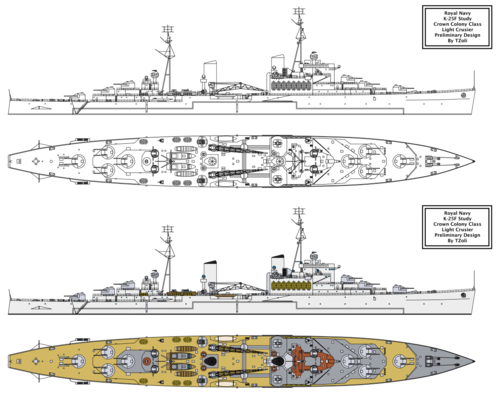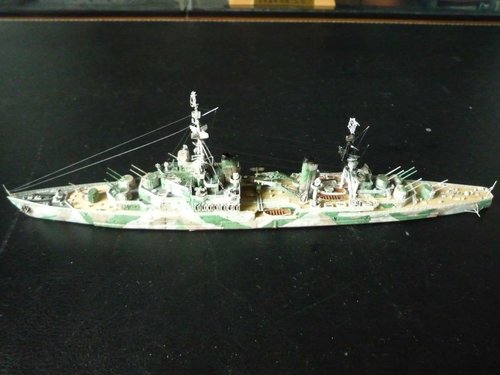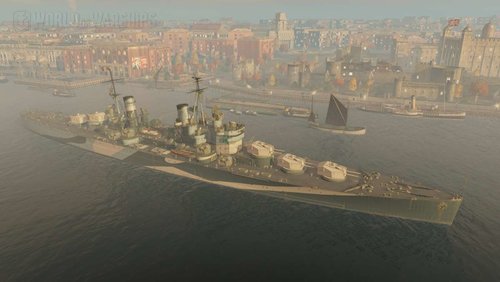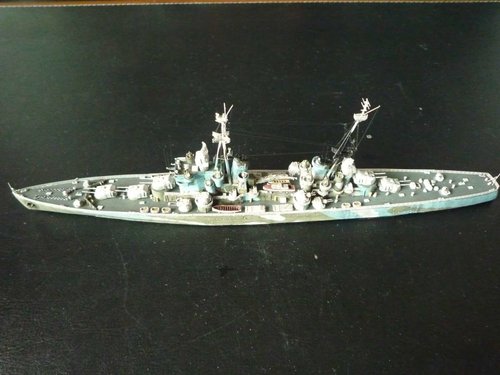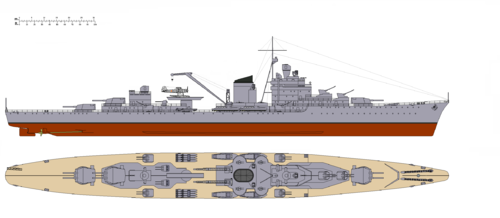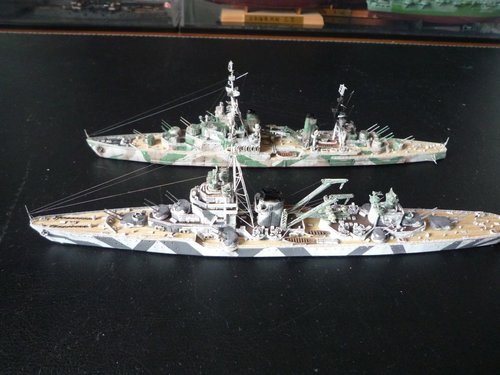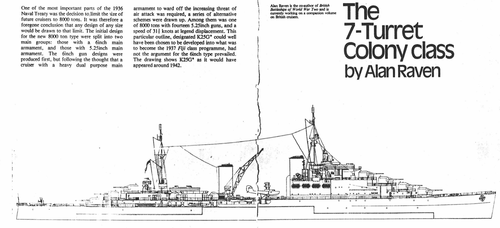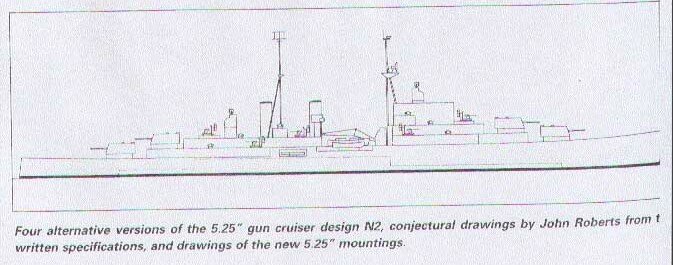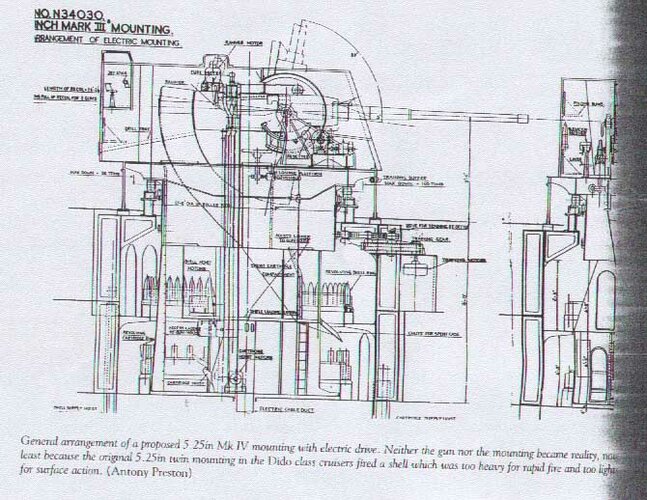You are using an out of date browser. It may not display this or other websites correctly.
You should upgrade or use an alternative browser.
You should upgrade or use an alternative browser.
RN AAcruiser
- Thread starter able
- Start date
able
ACCESS: Confidential
- Joined
- 20 February 2020
- Messages
- 63
- Reaction score
- 162
Using heavy cruiser to anti other cruisers, light cruiser to anti destorys, air defense cruiser to anti aircraft is not cost-effective. The general cruiser is coming out . In the history of the RN, there is a tradition of the main ship with light main gun and heavy auxiliary gun. Based on the Exeter, the project 131 of Spain is a suitable model. We can strengthen the dual-purpose gun from 120 to133 , which can take into account three mission requirements.
Attachments
Sherman Tank
I don't want to change my personal text
- Joined
- 14 October 2016
- Messages
- 235
- Reaction score
- 211
Who is "we"? And what evidence do you have that anything besides the Neptune/Minotaur and stolen Tzoli pictures you posted are real vessels?
- Joined
- 1 February 2011
- Messages
- 2,939
- Reaction score
- 3,624
Who is "we"? And what evidence do you have that anything besides the Neptune/Minotaur and stolen Tzoli pictures you posted are real vessels?
You do know I am here right?
While indeed I wasn't exactly asked for it to be shared BUT!!! I DO NOT MIND at all because it is my drawing and contains my signature which did not removed hence shows it is mine.
as for sources:
Norman Friedman - British Cruisers: Two World War and After
Norman Friedman - The Postwar Naval Revolution
Alan Raven, John Roberts - British Cruisers of World War Two
David K. Brown, George Moore - Rebuilding the Royal Navy: Warship Design Since 1945
some sketches from the books:
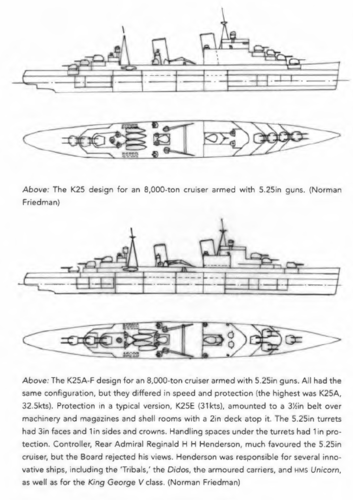
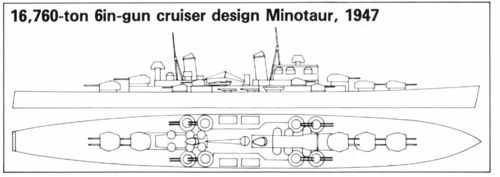

- Joined
- 1 February 2011
- Messages
- 2,939
- Reaction score
- 3,624
Is this the 5.25" cruiser Cunningham killed off in favour of 6" studies?
Sorta, they became the Crown Colony class
Volkodav
I really should change my personal text
- Joined
- 28 March 2014
- Messages
- 746
- Reaction score
- 1,270
Ok so this is an earlier 5.25' concept, I was not aware of it, thank you.Is this the 5.25" cruiser Cunningham killed off in favour of 6" studies?
Sorta, they became the Crown Colony class
- Joined
- 11 February 2007
- Messages
- 2,565
- Reaction score
- 4,362
The K25 series was not so much for an AA cruiser, but for a general purpose cruiser that happened to be AA capable - which also describes the intended role of the Didos, and similarly the intended flotilla leader role of the US Atlantas. For looks I prefer K25G with the four forward turrets all superfiring (and K25G* went right through to the final selection by the Admiralty Board, with Henderson as Controller throwing his weight behind it over K31, the final 6" design on offer), but the top-weight penalty would have been fearsome.
Pirate Pete
ACCESS: Secret
- Joined
- 25 July 2007
- Messages
- 351
- Reaction score
- 585
- Joined
- 11 February 2007
- Messages
- 2,565
- Reaction score
- 4,362
I think topweight might be a lesser problem on these designs as they only carry a pair of turrets more then a Dido yet on a larger hull
You're right that the larger hull would help, but the problem is not just the weight of the turrets, but their height - the significant factor is their moment arm, so it's weight times height above the waterline. And it isn't just the turrets we have to consider, the fourth superfiring forward turret pushes the bridge and everything above it up at least one deck level compared to the earlier K25 designs with four turrets on three levels. There's a similar effect at the stern, but here it's only the aft director (still a substantial weight) being pushed up a deck level compared to the earlier designs.
- Joined
- 1 February 2011
- Messages
- 2,939
- Reaction score
- 3,624
I've made some calculations based on the data from the navweaps site.
I don't know if on that site turret weight includes the guns themselves or not but I got these numbers:
6" BL Mark XXIII Guns:
7tons each
12x7=84tons total
turret weight used by the Crown Colony Class:
161tons each
4x161=644tons
together: 728tons
5,25" QF Mark I Guns
4,36tons each
14x4,36=61tons total
turret weight based on the Dido Class:
85-98tons each
7x85-98=595-686tons
together: 656-747tons
I don't know if on that site turret weight includes the guns themselves or not but I got these numbers:
6" BL Mark XXIII Guns:
7tons each
12x7=84tons total
turret weight used by the Crown Colony Class:
161tons each
4x161=644tons
together: 728tons
5,25" QF Mark I Guns
4,36tons each
14x4,36=61tons total
turret weight based on the Dido Class:
85-98tons each
7x85-98=595-686tons
together: 656-747tons
Volkodav
I really should change my personal text
- Joined
- 28 March 2014
- Messages
- 746
- Reaction score
- 1,270
These studies were on what became the Crown Colony Class and the Dido was evolved from the Arethusa, where there any 5.25" AA cruiser studies with the Leader or Modified Leander as the starting point? I don't recall ever seeing any but was wondering if any of you who have had access to source documents may have come across something?
- Joined
- 1 February 2011
- Messages
- 2,939
- Reaction score
- 3,624
The Leander class was not used for such studies.
The 5,25" Cruiser designs post Dido were the Emergency cruiser design from 1951, a modified Dido with 4 twin 5,25, and 3 twin Bofors 40mm with 6 twin 20mm Oerlikons
There was an 1936 project for a minelayer cruiser with 3 twin 5,25.
The Hawkins conversion project of 1938 with 6 twin 5,25
A Number of Crown Colony preliminaries of 1936 with mostly 7 twin mounts though there was one with 6 and another with 8 mounts
Vickers offered a design in 1936 with 8 twin mounts on a somewhat smaller smaller hull then the Crown Colony
Later an offer for Chile in 1939 for an export version of the Dido with 4 twin mounts (Design 1111)
some time later the same armament appeared on the 1940 design 1122 again an export version of the Dido
AA Cruiser Design K for the RN in 1940 offered only 3 twin mounts
In 1944 DNC offered a Cruiser for Australia with 4 triple turrets
Vickers offered Venezuela in 1945 again an export Dido variant with 4 twin mounts
And of course the secondary turrets on the KGV, Lion and Vanguard preliminaries as well as for the proposed modernizations of the Hood and Nelson classes.
These were the Mark I Guns
With the newer project of Mark IV guns:
there were a number of Neptune preliminaries of 1942 with 3,5 and even with 6 twin mounts or 3 and 4 triples.
Design N1 and N2 of 1943 with 4 twin mounts
Interestingly I've never seen a design with single 5,25" mounts or turrets say for a small cruiser or destroyer. (I did see once ages ago a hypothetical carrier model with single 5,25" turrets basically cut in half assymetrical Dido turrets)
The 5,25" Cruiser designs post Dido were the Emergency cruiser design from 1951, a modified Dido with 4 twin 5,25, and 3 twin Bofors 40mm with 6 twin 20mm Oerlikons
There was an 1936 project for a minelayer cruiser with 3 twin 5,25.
The Hawkins conversion project of 1938 with 6 twin 5,25
A Number of Crown Colony preliminaries of 1936 with mostly 7 twin mounts though there was one with 6 and another with 8 mounts
Vickers offered a design in 1936 with 8 twin mounts on a somewhat smaller smaller hull then the Crown Colony
Later an offer for Chile in 1939 for an export version of the Dido with 4 twin mounts (Design 1111)
some time later the same armament appeared on the 1940 design 1122 again an export version of the Dido
AA Cruiser Design K for the RN in 1940 offered only 3 twin mounts
In 1944 DNC offered a Cruiser for Australia with 4 triple turrets
Vickers offered Venezuela in 1945 again an export Dido variant with 4 twin mounts
And of course the secondary turrets on the KGV, Lion and Vanguard preliminaries as well as for the proposed modernizations of the Hood and Nelson classes.
These were the Mark I Guns
With the newer project of Mark IV guns:
there were a number of Neptune preliminaries of 1942 with 3,5 and even with 6 twin mounts or 3 and 4 triples.
Design N1 and N2 of 1943 with 4 twin mounts
Interestingly I've never seen a design with single 5,25" mounts or turrets say for a small cruiser or destroyer. (I did see once ages ago a hypothetical carrier model with single 5,25" turrets basically cut in half assymetrical Dido turrets)
- Joined
- 11 February 2007
- Messages
- 2,565
- Reaction score
- 4,362
Interestingly I've never seen a design with single 5,25" mounts or turrets say for a small cruiser or destroyer. (I did see once ages ago a hypothetical carrier model with single 5,25" turrets basically cut in half assymetrical Dido turrets)
ISTR the shore-based AA/Coastal defence mounts were singles.
- Joined
- 5 May 2007
- Messages
- 1,482
- Reaction score
- 2,859
Strictly speaking it's height above the centre of buoyancy that matters, which is why weight close to the waterline still causes stability problems.You're right that the larger hull would help, but the problem is not just the weight of the turrets, but their height - the significant factor is their moment arm, so it's weight times height above the waterline.
The centre of buoyancy is generally one-third to half the draught below the waterline, but that's a function of the hullform. As is the location of the metacentre, which is also calculated with respect to the centre of buoyancy. Keep the centre of gravity well below the metacentre or else you'll have a bad day at sea!
Because the shape of the immersed hull changes with displacement, weird things can happen sometimes. I've dealt with a barge loading condition where adding topweight actually improved stability by increasing the displaced volume significantly. But that isn't normal, and adding the same weight low down would have an even more beneficial effect.
- Joined
- 11 February 2007
- Messages
- 2,565
- Reaction score
- 4,362
Strictly speaking it's height above the centre of buoyancy that matters, which is why weight close to the waterline still causes stability problems.
The centre of buoyancy is generally one-third to half the draught below the waterline, but that's a function of the hullform. As is the location of the metacentre, which is also calculated with respect to the centre of buoyancy. Keep the centre of gravity well below the metacentre or else you'll have a bad day at sea!
Because the shape of the immersed hull changes with displacement, weird things can happen sometimes. I've dealt with a barge loading condition where adding topweight actually improved stability by increasing the displaced volume significantly. But that isn't normal, and adding the same weight low down would have an even more beneficial effect.
I couldn't remember metacentric height when I needed it, so went with waterline as sufficient to get the point across. But the actual detail makes the point even better.
I've just re-read the Forum rules and noticed that reopening topics with further info is OK. As the latest posts on here are 2010 and 2011, I did write an article for "Warship" 2010, page 43 (AA to AA - the Fijis turn full circle) which discussed the Fijis in detail with emphasis on the various AA variants from the K25's to the Tigers, and various emergency versions between. In it were drawings of all the Fiji preliminary designs, including the K25 AA versions by John Jordan based on Admiralty sketch design drawings. N2, the 1944 AA cruiser got a description as a footnote, but no drawing. There are drawings of N2 in George Moore's book "Building for Victory" though the automatic MkIII rectangular turrets he portrays were not available for a 1944 design, and I don't think he sticks very closely to the written description of "two funnels set close together roughly where the second turret stands" (on Royalist). There are drawings of an earlier automatic twin 5.25 in the Vickers archive in the Brrow library, which looked more like the curved top Mk I and II. I covered Dido's origins in an article on RN interwar small cruisers (Damnable Folly) in Warship 2011, p.130. Scylla and Charybdis had 4x2 4.5in to meet shortages of 5.25s
[D. Murfin]
[D. Murfin]
- Joined
- 22 April 2012
- Messages
- 2,258
- Reaction score
- 2,306
- Joined
- 31 May 2006
- Messages
- 657
- Reaction score
- 440
@smurf, it’s wonderful to see you posting here again. Thanks for the insight and welcome back, I hope you are well.
Seconded!
Thanks for the good wishes. A couple more points.
K31 was preferred not on top weight grounds, but because it was thought to have little chance against Japanese 8in gun cruisers - outranged by seriously heavier shells - while with twelve 6in firing faster than 8in K31 might fight an 8in cruiser.
As for top weight, K25 turrets would have had 3in armour, while the Mk I and MkII turrets for KGV and Didos had only 1in.
K31 was preferred not on top weight grounds, but because it was thought to have little chance against Japanese 8in gun cruisers - outranged by seriously heavier shells - while with twelve 6in firing faster than 8in K31 might fight an 8in cruiser.
As for top weight, K25 turrets would have had 3in armour, while the Mk I and MkII turrets for KGV and Didos had only 1in.
A Tentative Fleet Plan
I really should change my personal text
- Joined
- 9 April 2018
- Messages
- 1,212
- Reaction score
- 2,833
Had Henderson got K25G* built, and also successfully replaced the last few Didos with L.72 or L.90, roughly how many 5.25 mountings would be required?I've just re-read the Forum rules and noticed that reopening topics with further info is OK. As the latest posts on here are 2010 and 2011, I did write an article for "Warship" 2010, page 43 (AA to AA - the Fijis turn full circle) which discussed the Fijis in detail with emphasis on the various AA variants from the K25's to the Tigers, and various emergency versions between. In it were drawings of all the Fiji preliminary designs, including the K25 AA versions by John Jordan based on Admiralty sketch design drawings. N2, the 1944 AA cruiser got a description as a footnote, but no drawing. There are drawings of N2 in George Moore's book "Building for Victory" though the automatic MkIII rectangular turrets he portrays were not available for a 1944 design, and I don't think he sticks very closely to the written description of "two funnels set close together roughly where the second turret stands" (on Royalist). There are drawings of an earlier automatic twin 5.25 in the Vickers archive in the Brrow library, which looked more like the curved top Mk I and II. I covered Dido's origins in an article on RN interwar small cruisers (Damnable Folly) in Warship 2011, p.130. Scylla and Charybdis had 4x2 4.5in to meet shortages of 5.25s
[D. Murfin]
To replace the planned Fijis
1937 Prog 5 ships
1938 Prog 4 ships
1939 Prog 4 ships (2 to be built in the Royal Dockyards were cancelled on the outbreak of war)
That equals (at 7 turrets per ship) =91
Plus to repace the 3 1938 Prog Didos at 2 additional turrets each = 6
Grand total =97 plus spares additional turrets over the historical position.
6" Mk.XXIII saved = 52 + spares as planned
So the question is could the manufacturing capacity available build 2 5.25" turrets in the same time, or preferably better, than a single 6" triple.
The 6" Mk.XXIII turret was an existing design having been used for Edinburgh & Belfast. Historically the design of the new 5.25" turret was held up due to lack of drawing room staff at the same time as the KGV 14" turrets were being designed. The trial 5.25" mount didn't go to sea for trials in Iron Duke until early 1939. Manufacturing capacity was not adequate to deliver the historical 5.25" position on time hence it being decided on the outbreak of war to complete 2 of the 1938 Didos (Scylla & Charybdis) with 4.5" guns already ordered for D class conversions. 1936 and 1937 Didos were completed at the same time as the first 1937 Fijis and 3 Didos went to sea minus a turret.
I suspect that the result of choosing the K25G design would have seen their service entry delayed. The only question is by how much.
1937 Prog 5 ships
1938 Prog 4 ships
1939 Prog 4 ships (2 to be built in the Royal Dockyards were cancelled on the outbreak of war)
That equals (at 7 turrets per ship) =91
Plus to repace the 3 1938 Prog Didos at 2 additional turrets each = 6
Grand total =97 plus spares additional turrets over the historical position.
6" Mk.XXIII saved = 52 + spares as planned
So the question is could the manufacturing capacity available build 2 5.25" turrets in the same time, or preferably better, than a single 6" triple.
The 6" Mk.XXIII turret was an existing design having been used for Edinburgh & Belfast. Historically the design of the new 5.25" turret was held up due to lack of drawing room staff at the same time as the KGV 14" turrets were being designed. The trial 5.25" mount didn't go to sea for trials in Iron Duke until early 1939. Manufacturing capacity was not adequate to deliver the historical 5.25" position on time hence it being decided on the outbreak of war to complete 2 of the 1938 Didos (Scylla & Charybdis) with 4.5" guns already ordered for D class conversions. 1936 and 1937 Didos were completed at the same time as the first 1937 Fijis and 3 Didos went to sea minus a turret.
I suspect that the result of choosing the K25G design would have seen their service entry delayed. The only question is by how much.
- Joined
- 1 February 2011
- Messages
- 2,939
- Reaction score
- 3,624
Probably most of them would get the 4", 4,5" or even 4,7" twin mounts whatever the RN deem more anti surface fire would be required. A proposal for the USN to provide 5" twins might had been a choice too though, I doubt the USN too could provide the necessary mountings and guns.
Last edited:
A Tentative Fleet Plan
I really should change my personal text
- Joined
- 9 April 2018
- Messages
- 1,212
- Reaction score
- 2,833
i wasn't suggesting replacing the 1938 Didos with more 5.25in Fijis, but instead L.72 and L.90, which were preliminary designs for the L class Destroyer, roughly equivalent to the Mogador class contre-torpilleurs.snip
Sorry, I misunderstood.
So the additional 5.25" turret requirement drops to 76 (i.e. my original 97 less those for the 1938 Didos (being 5+2 for 3 ships)
Both L.72 and L.90 were to carry 4 twin 4.7" in weatherproof mounts (the Mk.XX from the L&M classes). That mount too was having to be designed at this busy period which is why come March 1940 half the L class were regunned with 4". The lengthened build times on these classes resulted in the second 1939 flotilla being the N class (repeat J/K). The alternative come war is to regun with something. Its a big "destroyer" for the 4". So maybe the twin 4.5" Mk.III UD mount. But I don't really see that option speeding up delivery that much - just look to Scylla & Charybdis which took about the same length of time to complete as the rest of the class.
L.72 2745 tons std 420ft long 35kts deep
L.90 3205 tons std 475ft long 36.5kts deep
Both with 4 twin 4.7" (50 degree elevation) in weatherproof mounts, 2 quad pom-pom, 2 new 0.661 multiple mounts, 8TT
Cost est £1.5m - double an L class and half that of a Dido.
So maybe 6 ships for the cost of the 1938 Didos and probably deliverable in the same timescale, end 1941 - mid 1942 at best. But not even equivalent to a full flotillas worth of destroyers and with an inferior HA armament when compared to a Dido. And it is too big to go to some of the traditional destroyer builders like White & Yarrow.
There is no way that the USN would be supplying that number of twin 5" mounts given the planned build programme for BB, Essex class CV and the massive cruiser programme.
So the additional 5.25" turret requirement drops to 76 (i.e. my original 97 less those for the 1938 Didos (being 5+2 for 3 ships)
Both L.72 and L.90 were to carry 4 twin 4.7" in weatherproof mounts (the Mk.XX from the L&M classes). That mount too was having to be designed at this busy period which is why come March 1940 half the L class were regunned with 4". The lengthened build times on these classes resulted in the second 1939 flotilla being the N class (repeat J/K). The alternative come war is to regun with something. Its a big "destroyer" for the 4". So maybe the twin 4.5" Mk.III UD mount. But I don't really see that option speeding up delivery that much - just look to Scylla & Charybdis which took about the same length of time to complete as the rest of the class.
L.72 2745 tons std 420ft long 35kts deep
L.90 3205 tons std 475ft long 36.5kts deep
Both with 4 twin 4.7" (50 degree elevation) in weatherproof mounts, 2 quad pom-pom, 2 new 0.661 multiple mounts, 8TT
Cost est £1.5m - double an L class and half that of a Dido.
So maybe 6 ships for the cost of the 1938 Didos and probably deliverable in the same timescale, end 1941 - mid 1942 at best. But not even equivalent to a full flotillas worth of destroyers and with an inferior HA armament when compared to a Dido. And it is too big to go to some of the traditional destroyer builders like White & Yarrow.
There is no way that the USN would be supplying that number of twin 5" mounts given the planned build programme for BB, Essex class CV and the massive cruiser programme.
Not all 5" but partial when the RN discovers it could not build the necessary amount of 5,25" turrets
Sorry. I thought you were talking about a replacement armament for the L.72/L.90 super destroyer not the K25G cruiser.
The idea of an 8000 ton cruiser armed with nothing more than 4.7” / 5” guns being designed in the run up to WW2 would just not be acceptable to anyone in the Admiralty.
- Joined
- 1 February 2011
- Messages
- 2,939
- Reaction score
- 3,624
I am talking about the K-25G if it would started building and the Admirality realised it could not produce the necessary amount of 5,25" guns and turrets and hence looking for other options. Like what happened with the Didos! I've just broadened the spectrum to RN 4 and 4,5" as well as USN 5" Guns and turrets.
ILikeTanks
ACCESS: Confidential
- Joined
- 16 January 2023
- Messages
- 70
- Reaction score
- 40
I've never heard of L.72/90 before. Would you mind sharing an image of the ship?Sorry, I misunderstood.
So the additional 5.25" turret requirement drops to 76 (i.e. my original 97 less those for the 1938 Didos (being 5+2 for 3 ships)
Both L.72 and L.90 were to carry 4 twin 4.7" in weatherproof mounts (the Mk.XX from the L&M classes). That mount too was having to be designed at this busy period which is why come March 1940 half the L class were regunned with 4". The lengthened build times on these classes resulted in the second 1939 flotilla being the N class (repeat J/K). The alternative come war is to regun with something. Its a big "destroyer" for the 4". So maybe the twin 4.5" Mk.III UD mount. But I don't really see that option speeding up delivery that much - just look to Scylla & Charybdis which took about the same length of time to complete as the rest of the class.
L.72 2745 tons std 420ft long 35kts deep
L.90 3205 tons std 475ft long 36.5kts deep
Both with 4 twin 4.7" (50 degree elevation) in weatherproof mounts, 2 quad pom-pom, 2 new 0.661 multiple mounts, 8TT
Cost est £1.5m - double an L class and half that of a Dido.
So maybe 6 ships for the cost of the 1938 Didos and probably deliverable in the same timescale, end 1941 - mid 1942 at best. But not even equivalent to a full flotillas worth of destroyers and with an inferior HA armament when compared to a Dido. And it is too big to go to some of the traditional destroyer builders like White & Yarrow.
There is no way that the USN would be supplying that number of twin 5" mounts given the planned build programme for BB, Essex class CV and the massive cruiser programme.
ILikeTanks
ACCESS: Confidential
- Joined
- 16 January 2023
- Messages
- 70
- Reaction score
- 40
They sound like modernized Tribal class destroyers in specifications.They are preliminary designs of the large L class destroyers. I don't think I've seen official or other drawings of them.
ptdockyard
"Pick out the biggest and commence firing"
- Joined
- 19 January 2014
- Messages
- 135
- Reaction score
- 202
ILikeTanks
ACCESS: Confidential
- Joined
- 16 January 2023
- Messages
- 70
- Reaction score
- 40
The author admitted using images of other ships from websites. This means that it is a mash-up of ship components made to ressemble specifications of L.90. And L class destroyers don't have names starting with G.
ptdockyard
"Pick out the biggest and commence firing"
- Joined
- 19 January 2014
- Messages
- 135
- Reaction score
- 202
Understood on the name. However it is close to the Warship drawing which was pretty basic.
Dave
Dave

